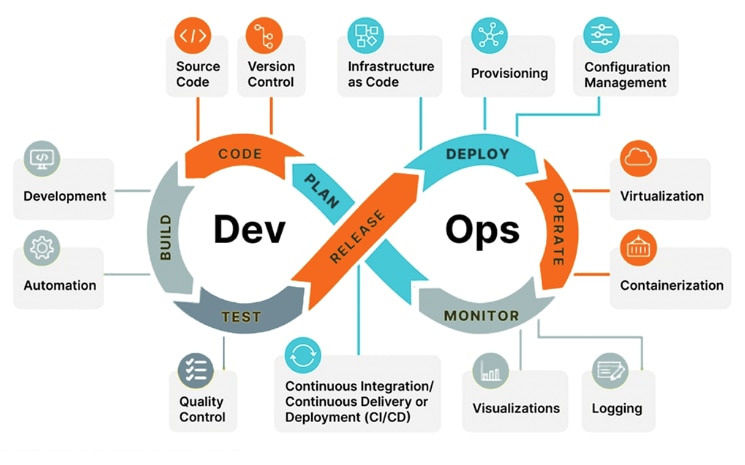This post was updated on June 19, 2024
If you look back to the state of technology only a few decades ago, you’ll stumble upon a technological world full of silos and frustration. Two of an organization’s most vital teams—software development and IT operations—struggled to communicate effectively. Departments resided within silos, and development and testing were conducted at a snail’s pace.
I still have flashbacks of a time when dev teams would build a package, throw it over the wall, and just wait for QA to provide feedback. There was absolutely no communication during development—only when the dev team considered the project “done.” Even companies deploying once a month ran into production issues.
Though this waterfall-based approach was inherently more conservative on paper, internal clashes made things remarkably difficult. Companies clearly needed to rethink their approaches. Long-standing development processes were leading to botched launches and rollbacks. Stakeholder priorities conflicted mightily with those of technical teams. Chains of productivity were fundamentally broken. Massive, monolithic source code changes were growing cumbersome, and even iterative changes induced headaches.
However, with the introduction of microservices—a groundbreaking new infrastructure model comprised of small code blocks and APIs built atop scalable cloud-computing deployments—Agile software development and lean methodologies became integral to maintaining these new deployments. After all, the codebases were shrinking, teams came to own their own features, and months-long testing was no longer necessary to guarantee core functionality.
And DevOps was born—ushering in elevated cohesiveness, efficiency, and a cultural renaissance across all business units.
In this guide, I’ll explain the ins and outs of DevOps, key best practices, and the criticality of cultural change in organizations to integrate DevOps methodologies and support better development practices, automated processes, and—ultimately—a better product.
How Does DevOps Work? DevOps Methodology Explained
Development and operations form the crux of DevOps. These two units form a tight-knit collaborative bond, and any software-related processes are equally designed around both teams. Additionally, effective implementation of DevOps is dependent on establishing an efficient pipeline. This cyclical collection of stages covers everything from planning to release and the capabilities needed within the delivery process:

Though “deliberate” development pacing was once commonplace, DevOps instead centers on agility. By tightly integrating the roles of engineers, testers, and administrators, companies can achieve new heights of productivity. The feedback loop is enormously integral to realizing these
DevOps benefits.
In a simple example, a developer will code a program and ship it off to testers for evaluation. Testers make notes and send feedback back to the engineers, who refine the product prior to deployment. This isn’t reserved just for beta periods prior to launch, since DevOps is a continual process spanning the entire software life cycle. Additionally, observing how this code (input) behaves when running in a test environment (output) tells developers and designers plenty about software readiness.
Additionally, DevOps was created to lower update failure rates, shorten recovery or remediation times, and promote faster releases. We’re naturally conditioned to link higher failure rates with increased release agility, but the pipeline helps boost reliability by wide margins.
The DevOps Research and Assessment (DORA) group evaluates how successfully organizations implement these processes. Companies are either low, medium, high, or elite performers. As expected, low performers release exceptionally infrequently, take a long time to fix issues, and experience failures more often. The opposite is true for elite performers—the best of the best, including household names like Google, PayPal, and Netflix. These companies have embraced DevOps completely and may deploy
over 100 times daily.
What Does a DevOps Role Do?
Each company generally implements its own unique flavor of DevOps, which can also take the form of other job titles. After all, DevOps engineers can oversee different products, use different tech stacks, and have varied job responsibilities depending on where the organization is in its digital transformation journey and whether cross-departmental collaboration between operations and other teams is crucial to business agility.
For example, DevSecOps is the intersection of DevOps and security and focuses on managing security throughout the feedback loop, which includes identifying, resolving, and managing bugs, vulnerabilities, and other security risks. A
site reliability engineer (SRE) is another role borrowing many DevOps methodologies, such as automating what can be automated, reducing tedious “busy work,” and freeing up time to focus on other tasks.
DevOps Best Practices
Regardless of job title, there are common DevOps principles applicable to many different types of roles and workplaces, including the synonymous principles of
continuous integration and continuous delivery or deployment (CI/CD) and the shift-left philosophy of CI/CD encouraging frequent testing as early as possible.
Traditionally, implementing strong CI/CD supported by adopting several purpose-built DevOps tools is how organizations try to optimize the full scope of development performance. However, implementing piecemeal solutions to address specific use cases and requirements—such as having a service management tool to react to incidents, a separate tool to monitor infrastructure performance, and another solution for managing assets—can lead to toolset creep, operational blind spots, and disjointed data.
To keep up with the demands and complexities of modern environments, operational-focused teams like DevOps are shifting to using full-stack observability solutions. Observability combines network, cloud, system, application, services, and database metrics into a single source of truth. Observability supports the ability to delve more easily deeper into
performance analytics, identify greater workflow efficiencies and automation opportunities across organizations, and streamline the closed-loop management every DevOps practitioner holds near and dear.
Also, gather as much feedback as you can. Be sure to check in with your teams to ensure smooth progress on projects and builds.
This comes with a caveat, however. I recommend being wary of hanging on to feedback without moving through the feedback loop. I’ve seen where getting bogged down can become counterproductive. Taking proactive and reactive steps to fix problems is essential, and you can do so by understanding how to interpret and relay findings.
Last but certainly not least, remain mindful of your organizational goals. Perhaps you’ve aced observability but your early development pipeline is undeveloped. Know your strengths and weaknesses and strategize accordingly.
The Importance of Adopting a DevOps Culture
Though DevOps is a technical methodology, it’s also an inherently human approach. DevOps embraces agility and problem-solving. Collaboration is central. Having a DevOps mindset encourages broader communication instead of sticking strictly to one discipline.
This is antithetical to many organizations—especially traditional ones. Getting on board with DevOps might require a cultural shift or even a reorganization. Accordingly, there must be a focus on shedding blame for any failures. By focusing on the problem, you can prevent failures from recurring without alienating team members. Remember, each link in the chain is important.
If there's one thing I've gathered from those intimately familiar with DevOps, it's development teams and operations teams must dive in headfirst to enjoy success. Though company culture doesn’t shift radically overnight, organizations can adjust their existing processes to implement these core DevOps best practices into everyday workflows. It's impossible to halfheartedly adopt these practices and gain the full scope of
DevOps benefits in return. So, don't adopt DevOps because it's trendy; do it because the data for how DevOps can improve your development workflow shows clear benefits.
While improving workflows is key to building stronger development processes, making sure you have the right insights across your IT infrastructure can be just as crucial.
SolarWinds® Observability is designed to provide the centralized, comprehensive performance monitoring data and insights DevOps, ITOps, and security teams need to act quickly and more efficiently.
 Though “deliberate” development pacing was once commonplace, DevOps instead centers on agility. By tightly integrating the roles of engineers, testers, and administrators, companies can achieve new heights of productivity. The feedback loop is enormously integral to realizing these DevOps benefits.
Though “deliberate” development pacing was once commonplace, DevOps instead centers on agility. By tightly integrating the roles of engineers, testers, and administrators, companies can achieve new heights of productivity. The feedback loop is enormously integral to realizing these DevOps benefits.







